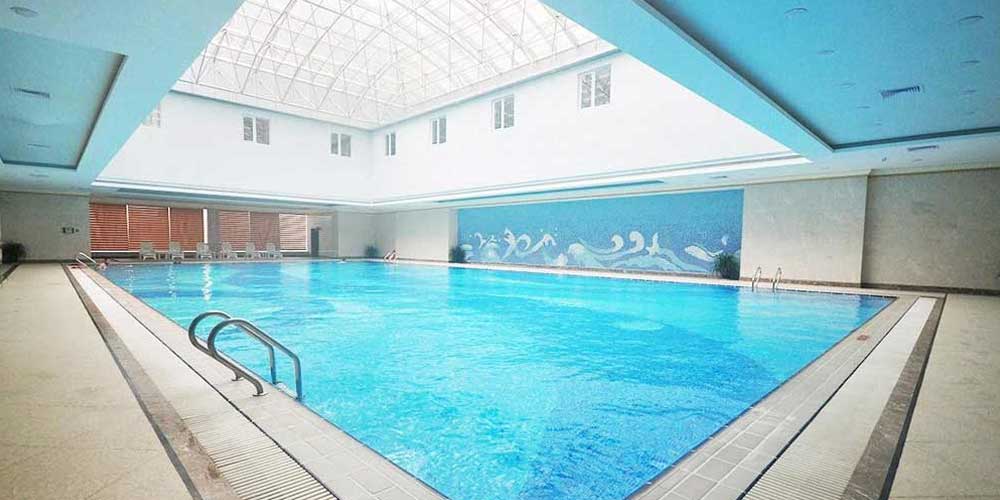పూల్ నిర్వహణ ప్రపంచంలో, తరచుగా చర్చించబడే ఒక ముఖ్యమైన రసాయనంసైనూరిక్ ఆమ్లం. ఈ సమ్మేళనం కొలను నీటిని సురక్షితంగా మరియు పారదర్శకంగా ఉంచడంలో కీలక పాత్ర పోషిస్తుంది. అయితే, చాలా మంది కొలను యజమానులు సైనూరిక్ ఆమ్లం ఎక్కడి నుండి వస్తుంది మరియు అది వారి కొలనులలో ఎలా ముగుస్తుంది అని ఆలోచిస్తారు. ఈ వ్యాసంలో, ఈత కొలనులలో సైనూరిక్ ఆమ్లం యొక్క మూలాలను మనం అన్వేషిస్తాము మరియు కొలను రసాయన శాస్త్రంలో దాని ప్రాముఖ్యతను వెలుగులోకి తెస్తాము.
సైనూరిక్ ఆమ్లం యొక్క మూలాలు
సైనూరిక్ ఆమ్లం, CYA లేదా స్టెబిలైజర్ అని కూడా పిలుస్తారు, ఇది సూర్యుని అతినీలలోహిత (UV) కిరణాల నుండి క్లోరిన్ను రక్షించడానికి ఈత కొలనులలో ప్రధానంగా ఉపయోగించే రసాయన సమ్మేళనం. సైనూరిక్ ఆమ్లం లేకుండా, సూర్యరశ్మికి గురైనప్పుడు క్లోరిన్ త్వరగా క్షీణిస్తుంది, దీని వలన కొలను నీటిని శుభ్రపరచడంలో ఇది తక్కువ ప్రభావవంతంగా ఉంటుంది.
పూల్ రసాయన చేరికలు: కొలనులలో సైనూరిక్ ఆమ్లం యొక్క ఒక సాధారణ మూలం ఉద్దేశపూర్వకంగా పూల్ రసాయనాలను జోడించడం. పూల్ యజమానులు మరియు ఆపరేటర్లు తరచుగా వారి కొలనులకు స్టెబిలైజర్గా సైనూరిక్ ఆమ్ల కణికలు లేదా మాత్రలను జోడిస్తారు. ఈ ఉత్పత్తులు కాలక్రమేణా కరిగి, సైనూరిక్ ఆమ్లాన్ని నీటిలోకి విడుదల చేస్తాయి.
క్లోరిన్ టాబ్లెట్లు: పూల్ పారిశుధ్యం కోసం ఉపయోగించే కొన్ని క్లోరిన్ టాబ్లెట్లలో సైనూరిక్ ఆమ్లం ఒక పదార్ధంగా ఉంటుంది. ఈ టాబ్లెట్లను పూల్ స్కిమ్మర్లు లేదా ఫ్లోటర్లలో ఉంచినప్పుడు, అవి సరైన పూల్ కెమిస్ట్రీని నిర్వహించడానికి నెమ్మదిగా క్లోరిన్ మరియు సైనూరిక్ ఆమ్లం రెండింటినీ నీటిలోకి విడుదల చేస్తాయి.
పర్యావరణ కారకాలు: సైనూరిక్ ఆమ్లం పర్యావరణ కారకాల ద్వారా కూడా కొలను నీటిలోకి ప్రవేశించవచ్చు. వాయు కాలుష్యం లేదా ఇతర వనరుల నుండి సైనూరిక్ ఆమ్లం కలిగి ఉన్న వర్షపు నీరు దానిని కొలనులోకి ప్రవేశపెట్టవచ్చు. అదేవిధంగా, దుమ్ము, శిధిలాలు మరియు కొలనులో పేరుకుపోయే ఆకులు కూడా సైనూరిక్ ఆమ్ల స్థాయిలకు దోహదం చేస్తాయి.
స్ప్లాష్ అవుట్ మరియు బాష్పీభవనం: పూల్ నుండి నీరు చిమ్ముతున్నప్పుడు లేదా ఆవిరైపోతున్నప్పుడు, సైనూరిక్ ఆమ్లంతో సహా రసాయనాల సాంద్రత పెరుగుతుంది. పూల్ నీటిని తిరిగి నింపినప్పుడు, అది మునుపటి పూరక లేదా మూల నీటి నుండి సైనూరిక్ ఆమ్లాన్ని కలిగి ఉండవచ్చు.
సైనూరిక్ ఆమ్లం యొక్క ప్రాముఖ్యత
ఈత కొలనులలో ప్రభావవంతమైన క్లోరిన్ స్థాయిని నిర్వహించడానికి సైనూరిక్ ఆమ్లం చాలా ముఖ్యమైనది. ఇది క్లోరిన్ అణువుల చుట్టూ ఒక రక్షణ కవచాన్ని ఏర్పరుస్తుంది, UV కిరణాలకు గురైనప్పుడు అవి విచ్ఛిన్నం కాకుండా నిరోధిస్తుంది. ఈ స్థిరీకరణ ప్రభావం క్లోరిన్ నీటిలో ఉండటానికి మరియు బ్యాక్టీరియా మరియు ఇతర కలుషితాలను చంపడం ద్వారా కొలనును శుభ్రపరచడంలో దాని పాత్రను కొనసాగించడానికి అనుమతిస్తుంది.
అయితే, సైనూరిక్ ఆమ్ల స్థాయిలతో సమతుల్యతను సాధించడం చాలా అవసరం. అధిక మొత్తంలో "క్లోరిన్ లాక్" అని పిలువబడే పరిస్థితికి దారితీయవచ్చు, ఇక్కడ సైనూరిక్ ఆమ్ల సాంద్రత చాలా ఎక్కువగా ఉంటుంది, క్లోరిన్ తక్కువ ప్రభావవంతంగా ఉంటుంది. మరోవైపు, చాలా తక్కువ సైనూరిక్ ఆమ్లం వేగంగా క్లోరిన్ విసర్జించబడటానికి దారితీస్తుంది, తరచుగా రసాయన జోడింపుల అవసరాన్ని పెంచుతుంది.
ఈత కొలనులలో సైనూరిక్ ఆమ్లం ప్రధానంగా ఉద్దేశపూర్వక రసాయన చేర్పులు, క్లోరిన్ మాత్రలు, పర్యావరణ కారకాలు మరియు నీటిని తిరిగి నింపడం నుండి వస్తుంది. సరైన పూల్ కెమిస్ట్రీని నిర్వహించడానికి సైనూరిక్ ఆమ్లం యొక్క మూలాలను అర్థం చేసుకోవడం చాలా ముఖ్యం. ఈతగాళ్లకు వారి పూల్లు సురక్షితంగా మరియు స్పష్టంగా ఉండేలా చూసుకోవడానికి పూల్ యజమానులు క్రమం తప్పకుండా సైనూరిక్ ఆమ్ల స్థాయిలను పరీక్షించి పర్యవేక్షించాలి. సరైన సమతుల్యతను సాధించడం ద్వారా, పూల్ ఔత్సాహికులు ఈత సీజన్ అంతటా మెరిసే, బాగా నిర్వహించబడిన నీటిని ఆస్వాదించవచ్చు.
పోస్ట్ సమయం: డిసెంబర్-08-2023


